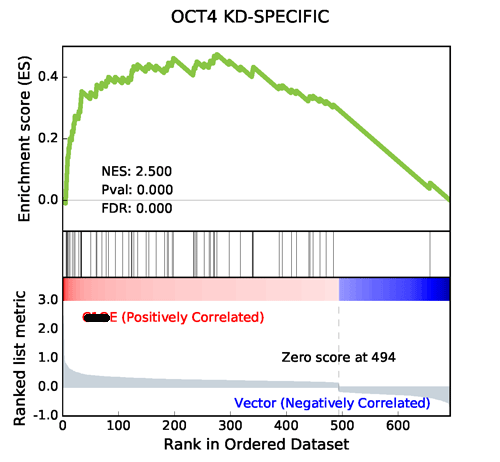


Release notes : https://github.com/zqfang/GSEApy/releases
- See Frequently Asked Questions
- Visit the document site at Examples
- The GSEApy discussion channel: Q&A
GSEApy can be used for RNA-seq, ChIP-seq, Microarray data. It can be used for convenient GO enrichment and to produce publication quality figures in python.
GSEApy has six sub-commands available: gsea, prerank, ssgsea, replot enrichr, biomart.
| gsea: | The gsea module produces GSEA results. The input requries a txt file(FPKM, Expected Counts, TPM, et.al), a cls file, and gene_sets file in gmt format. |
|---|---|
| prerank: | The prerank module produces Prerank tool results. The input expects a pre-ranked gene list dataset with correlation values, provided in .rnk format, and gene_sets file in gmt format. prerank module is an API to GSEA pre-rank tools. |
| ssgsea: | The ssgsea module performs single sample GSEA(ssGSEA) analysis. The input expects a pd.Series (indexed by gene name), or a pd.DataFrame (include GCT file) with expression values and a GMT file. For multiple sample input, ssGSEA reconigzes gct format, too. ssGSEA enrichment score for the gene set is described by D. Barbie et al 2009. |
| replot: | The replot module reproduce GSEA desktop version results. The only input for GSEApy is the location to GSEA Desktop output results. |
| enrichr: | The enrichr module enable you perform gene set enrichment analysis using Enrichr API. Enrichr is open source and freely available online at: http://amp.pharm.mssm.edu/Enrichr . It runs very fast. |
| biomart: | The biomart module helps you convert gene ids using BioMart API. |
Please use 'gseapy COMMAND -h' to see the detail description for each option of each module.
The full GSEA is far too extensive to describe here; see
GSEA documentation for more information. All files' formats for GSEApy are identical to GSEA desktop version.
If you use gseapy in your research, you should cite the original ``GSEA`` and ``Enrichr`` paper.
I would like to use Pandas to explore my data, but I did not find a convenient tool to do gene set enrichment analysis in python. So, here are my reasons:
- Ability to run inside python interactive console without having to switch to R!!!
- User friendly for both wet and dry lab users.
- Produce or reproduce publishable figures.
- Perform batch jobs easy.
- Easy to use in bash shell or your data analysis workflow, e.g. snakemake.
Using the same data from GSEA, GSEApy reproduce the example above.
Using Prerank or replot module will reproduce the same figure for GSEA Java desktop outputs

Generated by GSEApy
GSEApt figures are supported by all matplotlib figure formats.
You can modify GSEA plots easily in .pdf files. Please Enjoy.
# if you have conda
$ conda install -c conda-forge -c bioconda gseapy
# or use pip to install the latest release
$ pip install gseapy$ pip install git+git://github.com/zqfang/gseapy.git#egg=gseapy- Python 3.5+
- Numpy >= 1.13.0
- Scipy
- Pandas
- Matplotlib
- Requests (for Enrichr API)
- Bioservices (for BioMart API)
Unless you know exactly how GSEA works, you should convert all gene symbol names to uppercase first.
# An example to reproduce figures using replot module.
$ gseapy replot -i ./Gsea.reports -o test
# An example to run GSEA using gseapy gsea module
$ gseapy gsea -d exptable.txt -c test.cls -g gene_sets.gmt -o test
# An example to run Prerank using gseapy prerank module
$ gseapy prerank -r gsea_data.rnk -g gene_sets.gmt -o test
# An example to run ssGSEA using gseapy ssgsea module
$ gseapy ssgsea -d expression.txt -g gene_sets.gmt -o test
# An example to use enrichr api
# see details of -g below, -d is optional
$ gseapy enrichr -i gene_list.txt -g KEGG_2016 -d pathway_enrichment -o test- Prepare expression.txt, gene_sets.gmt and test.cls required by GSEA, you could do this
import gseapy
# run GSEA.
gseapy.gsea(data='expression.txt', gene_sets='gene_sets.gmt', cls='test.cls', outdir='test')
# run prerank
gseapy.prerank(rnk='gsea_data.rnk', gene_sets='gene_sets.gmt', outdir='test')
# run ssGSEA
gseapy.ssgsea(data="expression.txt", gene_sets= "gene_sets.gmt", outdir='test')
# An example to reproduce figures using replot module.
gseapy.replot(indir='./Gsea.reports', outdir='test')- If you prefer to use Dataframe, dict, list in interactive python console, you could do this.
see detail here: Example
# assign dataframe, and use enrichr library data set 'KEGG_2016'
expression_dataframe = pd.DataFrame()
sample_name = ['A','A','A','B','B','B'] # always only two group,any names you like
# assign gene_sets parameter with enrichr library name or gmt file on your local computer.
gseapy.gsea(data=expression_dataframe, gene_sets='KEGG_2016', cls= sample_names, outdir='test')
# using prerank tool
gene_ranked_dataframe = pd.DataFrame()
gseapy.prerank(rnk=gene_ranked_dataframe, gene_sets='KEGG_2016', outdir='test')
# using ssGSEA
gseapy.ssgsea(data=ssGSEA_dataframe, gene_sets='KEGG_2016', outdir='test')- For
enrichr, you could assign a list, pd.Series, pd.DataFrame object, or a txt file (should be one gene name per row.)
# assign a list object to enrichr
gl = ['SCARA3', 'LOC100044683', 'CMBL', 'CLIC6', 'IL13RA1', 'TACSTD2', 'DKKL1', 'CSF1',
'SYNPO2L', 'TINAGL1', 'PTX3', 'BGN', 'HERC1', 'EFNA1', 'CIB2', 'PMP22', 'TMEM173']
gseapy.enrichr(gene_list=gl, description='pathway', gene_sets='KEGG_2016', outdir='test')
# or a txt file path.
gseapy.enrichr(gene_list='gene_list.txt', description='pathway', gene_sets='KEGG_2016',
outdir='test', cutoff=0.05, format='png' )To see the full list of gseapy supported gene set libraries, please click here: Library
Or use get_library_name function inside python console.
#see full list of latest enrichr library names, which will pass to -g parameter:
names = gseapy.get_library_name()
# show top 20 entries.
print(names[:20])
['Genome_Browser_PWMs',
'TRANSFAC_and_JASPAR_PWMs',
'ChEA_2013',
'Drug_Perturbations_from_GEO_2014',
'ENCODE_TF_ChIP-seq_2014',
'BioCarta_2013',
'Reactome_2013',
'WikiPathways_2013',
'Disease_Signatures_from_GEO_up_2014',
'KEGG_2016',
'TF-LOF_Expression_from_GEO',
'TargetScan_microRNA',
'PPI_Hub_Proteins',
'GO_Molecular_Function_2015',
'GeneSigDB',
'Chromosome_Location',
'Human_Gene_Atlas',
'Mouse_Gene_Atlas',
'GO_Cellular_Component_2015',
'GO_Biological_Process_2015',
'Human_Phenotype_Ontology',]If you would like to report any bugs when use gseapy, don't hesitate to create an issue on github here.
- See Frequently Asked Questions
- Visit the document site at Examples
- The GSEApy discussion channel: Q&A
